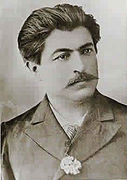Arts and entertainment
- Sarkis Djanbazian – (15 January 1913, Armavir – 11 December 1963, Tehran) ballet master, dancer, choreographer and producer. [1]
- Lilit Teryan – (31 December 1930, Tehran – 7 March 2019, Tehran) sculptor. [2]
Music
- Aram Gharabekian – (4 July 1955, Tehran – 10 January 2014, Los Angeles) conductor. [3]
Singers
- Hovhannes Badalyan – (15 December 1924, Shavarin – 19 August 2001, Yerevan) singer. [4]
- Viguen – (23 November 1929, Hamadan – 26 October 2003, Los Angeles) singer and actor. [5]
- Andy – (22 April 1958, Tehran) singer-songwriter and actor; Iranian Armenian-Armenian. [6]
Composers and instrumentalists
- Hambarsoom Grigorian – (1893 in Tabriz – 28 July 1975, Tehran) composer. [7]
- Ivan Galamian – (23 January 1903 – 14 April 1981) violinist, teacher; Iranian Armenian-American. [8]
- Robert Atayan – (7 November 1915, Tehran – 4 March 1994, Los Angeles) musicologist and composer. [9]
- Varoujan Hakhbandian – (4 December 1936, Qazvin – 17 September 1977, Tehran) composer and songwriter. [10]
- Loris Tjeknavorian – (13 October 1937, Boroujerd) composer and conductor. [11]
- Armik – (1950s, Tabriz) guitarist, producer and composer. [12]
- Vartan Vahramian – (1955, Tabriz) composer and painter. [13]
- Khachik Babayan – (1956, Tabriz) violinist. [14]
- Armen Ra – (1969, Tehran) thereminist. [15]
- Varoujan Hakhbandian
(1936–1977) - Loris Tjeknavorian
(1937)
Filmmaking
- Ray Aghayan – (28 July 1928, Tehran – 10 October 2011, Los Angeles) fashion designer and costume designer; Iranian Armenian-American. [16]
Actors
- Murad Kostanyan – (25 August 1902, Haftvan, Salmas – 3 January 1989, Yerevan) actor. [17]
- Loreta – (1911, Tehran – 29 March 1998, Vienna) actress. [18]
- Annik Shefrazian – (1909, Isfahan – 28 December 1996, Kahrizak) actress. [19]
- Arman – (21 February 1921, Tabriz – 18 August 1980, Barcelona) actor. [20]
- Yervand Manaryan – (20 September 1924, Arak – 19 February 2020) actor. [21]
- Irene Zazians – (20 August 1927, Babolsar – 28 July 2012, Tehran) actress. [22]
- Aramazd Stepanian – (11 October 1951, Abadan) actor, producer, director and playwright. [23]
- Mary Apick – (16 June 1954, Tehran) actress. [24]
- Marco Khan – (27 March 1961, Tehran) actor and stunt performer; Iranian-born Armenian-American. [25]
- Vahik Pirhamzei – (6 November 1968) actor, producer, director and writer. [26]
- Mahaya Petrosian – (3 January 1970, Tehran) actress. [27]
- Irene Zazians
(1927–2012) - Mahaya Petrosian
(1970)
Directors
- Ovanes Ohanian – (8 October 1896, Mashhad – September 1961, Tehran) film director. [28]
- Aramais Aghamalian – (1910, Julfa – 1985, Tehran) film director and screenwriter. [29]
- Mushegh Sarvarian – (15 February 1910, Tehran – 13 August 1981, Tehran) film director. [30]
- Samuel Khachikian – (21 October 1923 – 22 October 2001) film director, screenwriter, author, and film editor. [31]
- Arman Manaryan – (15 December 1929, Arak – 16 February 2016) film director. [32]
- Robert Ekhart – (1935, Tabriz – 1994, Los Angeles) film director. [33]
- Varuzh Karim-Masihi – (1953, Arak) film director, film editor, and screenplay writer. [34]
- Ovanes Ohanian
(1896–1961) - Samuel Khachikian
(1923–2001)
Painters, photogeraphers and cartoonists
- Bogdan Saltanov – (1630s, New Julfa – 1703, Moscow) painter; Persian-born Armenian. [35]
- Antoin Sevruguin – (1851, Tehran – 1933, Tehran) photographer. [36]
- Sumbat Der Kiureghian – (19 October 1913, Isfahan – June 9, 1999, Los Angeles) watercolor painter. [37]
- Marcos Grigorian – (5 December 1925 – 27 August 2007) painter and gallery owner. [38]
- Nikol Faridani – (25 January 1936, Shiraz – 6 February 2008) photographer. [39]
- Antoin Sevruguin
(1851–1933)





















